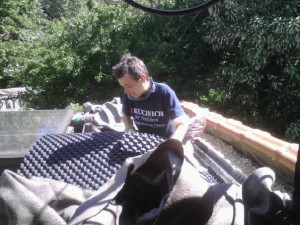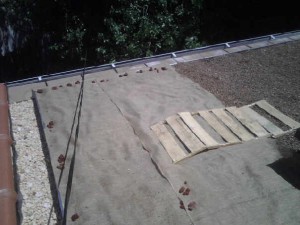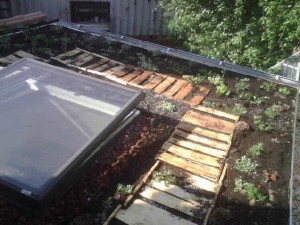I dedicate this post to the staff of Just Food, an excellent organization that works to ensure the availability of fresh food in all New York neighborhoods by supporting community gardening and forging connections between communities and local farmers. Read about Just Food here, but more importantly, throw money at them here. I am proud to say that I recently joined JF’s advisory board.
Here in New York and in other big cities we have the heat island effect. The lack of vegetation and the black-top roofs mean that extra heat is absorbed so more energy is required to cool buildings.
Another problem, because of all the cement and asphalt surfaces, is that storm water ends up running off the ground and into the sewers, often causing raw sewage to overflow into the waterways out of what are called “combined sewer overflows” (read more here).
This is why I love green roofs–the use of vegetation to cover roofs in cities like New York. They both keep the buildings cooler (and warmer in winter)–substantially reducing energy use–and absorb storm water so it never reaches the sewers. Not to mention reducing outside noise, restoring bird and butterfly habitat, and increasing the life of the roof.
Synergy (or, for long term readers who know my turns of phrase, happier planet, happier people). I love synergies–solutions that solve more than one environmental or social problem.
But listen. If I dig green roofs (pun unintended but credit still deserved), imagine how much more I dig green roofs that also provide vegetables (more synergy). As you know, part of No Impact was also eating only local food (for reasons explained here and here). How much more local can you get than your roof?
But also, growing food on urban roofs may have the potential of turning local food from a hobby of the elite to a lifeline for the urban poor (even more synergy). Because the quality of available food in underprivileged neighborhoods is often appalling (KFC and MacDonalds but no fresh vegetables). Indeed, my friend Kerry Truman has a story on Huffington on urban food justice here.
I’d love to see vegetables growing on roofs all over New York (hint, hint, Jacquie, and you know who you are).
But I’m going on. What I wanted to do here is give you a glimpse of some cool photos by my eco-hero Kate Zidar of the green roof vegetable garden that she built with my other eco-hero and green roof expert Atom Cianfarani. At the bottom of the post, I include some links to do with urban rooftop farming.
And by the way, this roof that Kate and Atom built is on the top of Habana Outpost, a Brooklyn restaurant that works darn hard at sustainability (and is fun as all hell, too!). It’s part of the work of the restaurant’s associated non-profit, Habana Works.
Below is Atom. She’s already laid down a rubber membrane that protects the conventional roof from water and infiltration by plant roots. Then she put down a polypropylene felt-like layer to cushion the membrane from footsteps and to absorb water. Now she’s putting down another layer that looks like egg cartons that serves the function of both providing drainage and retaining water. All Atom’s materials, with the exception of the membrane, are 100% recycled or reused.

After the drainage layer comes very lightweight “Gaia soil,” produced by New York’s Gaia Institute. Because it is so light, Atom covers it with burlap. The burlap will, in turn, be covered with compost. When Kate, who’s in charge of the gardening, puts in the plants, she’ll cut holes in the burlap.

Voila! In this case, the garden supports strawberries and herbs, in part because Kate did not want it to have to require irrigation. But she and Atom are planning another rooftop garden with a more extensive collection of vegetables that will harvest and store rainwater for irrigation.

- A story about a vegetable garden on the roof of the Environmental Science building at Trent University featuring some pretty darn cool photos of what a roof can look like.
- An excellent study of the potential of roof top gardens to provide food.
- A really excellent guide for low-cost gardening on roofs using children’s plastic wading pools as containers. This method may not retain the same amount of storm water but may be more feasible in low-income neighborhoods.
- Another guide to rooftop vegetable gardening using containers.